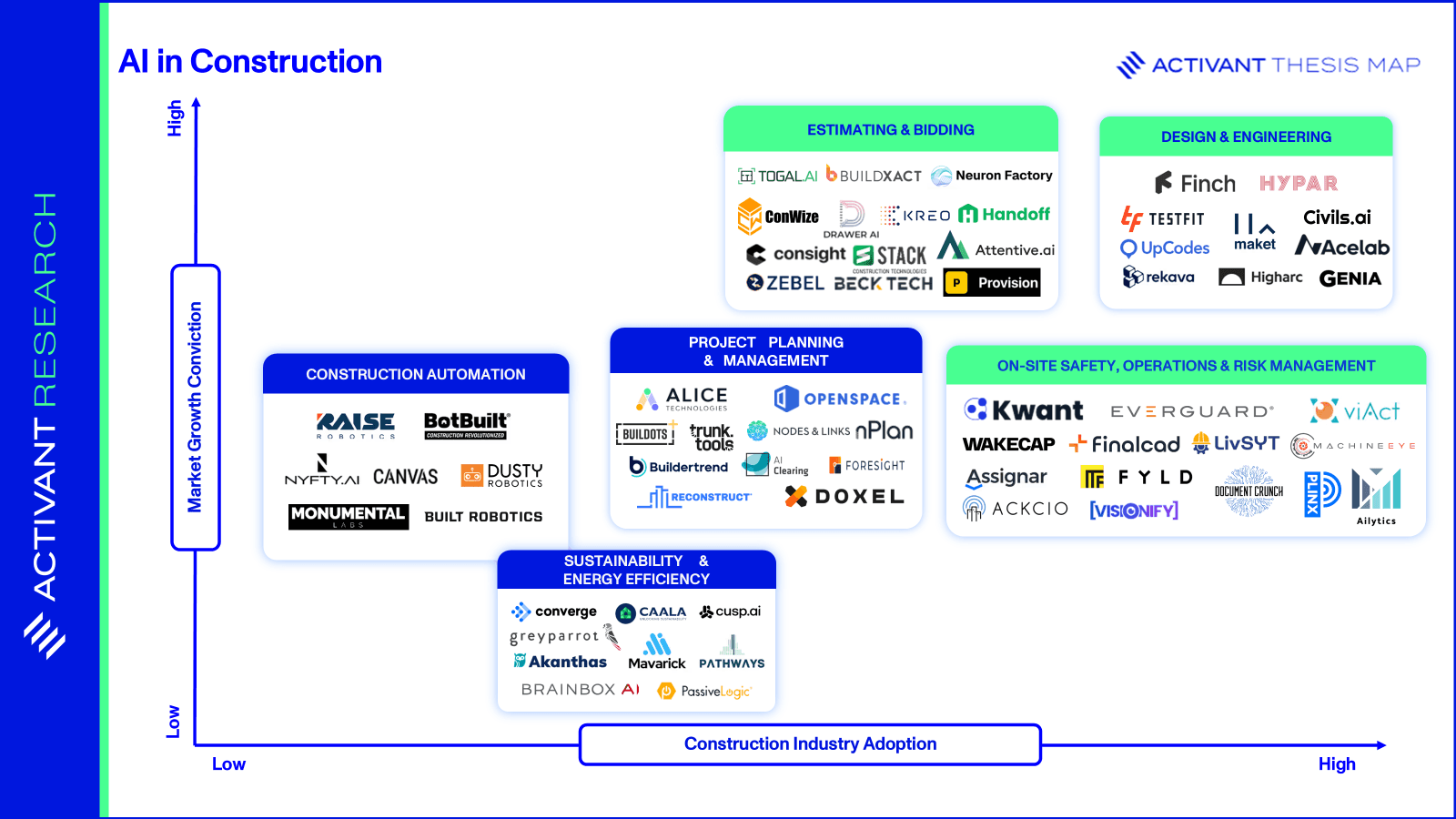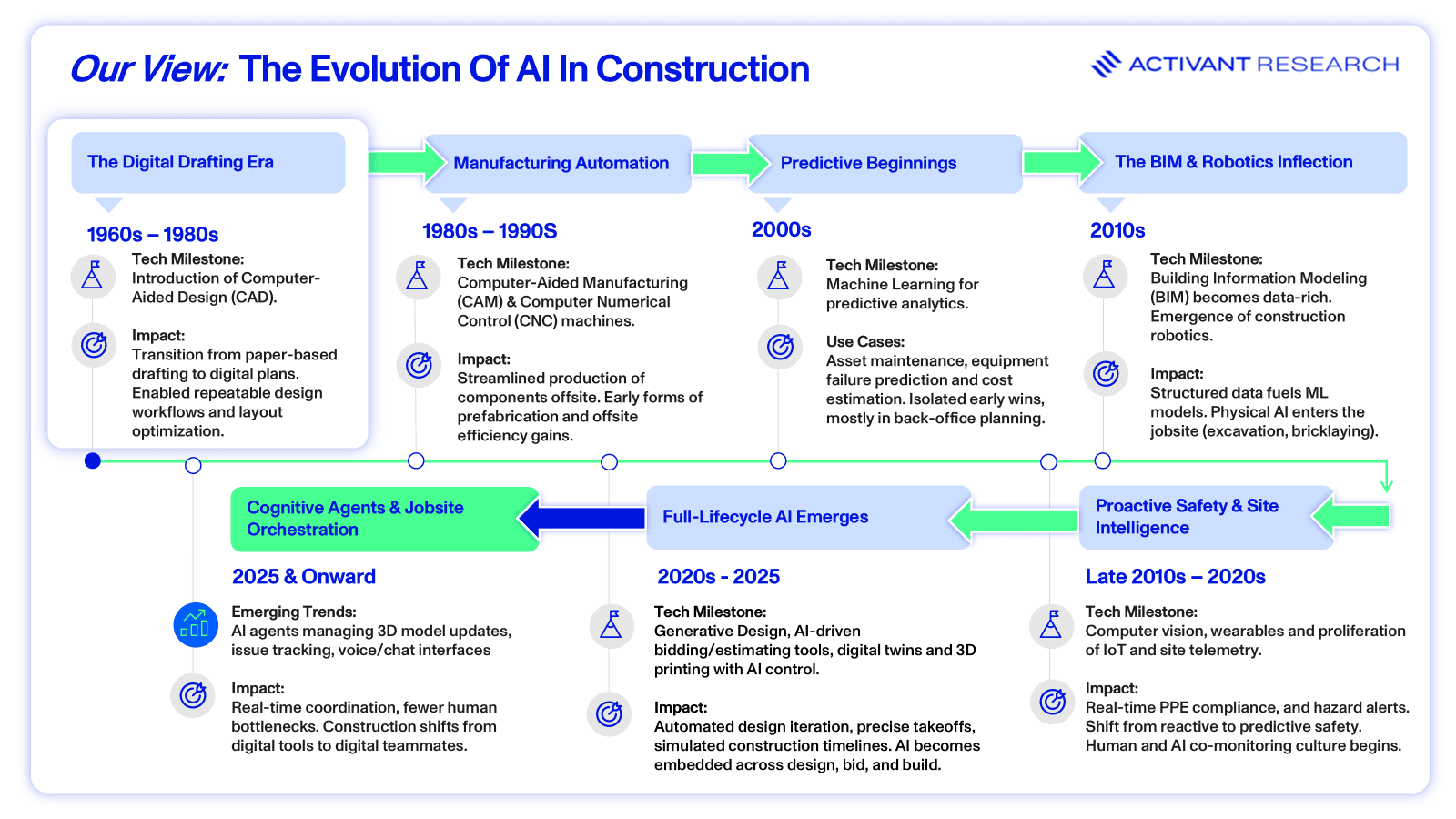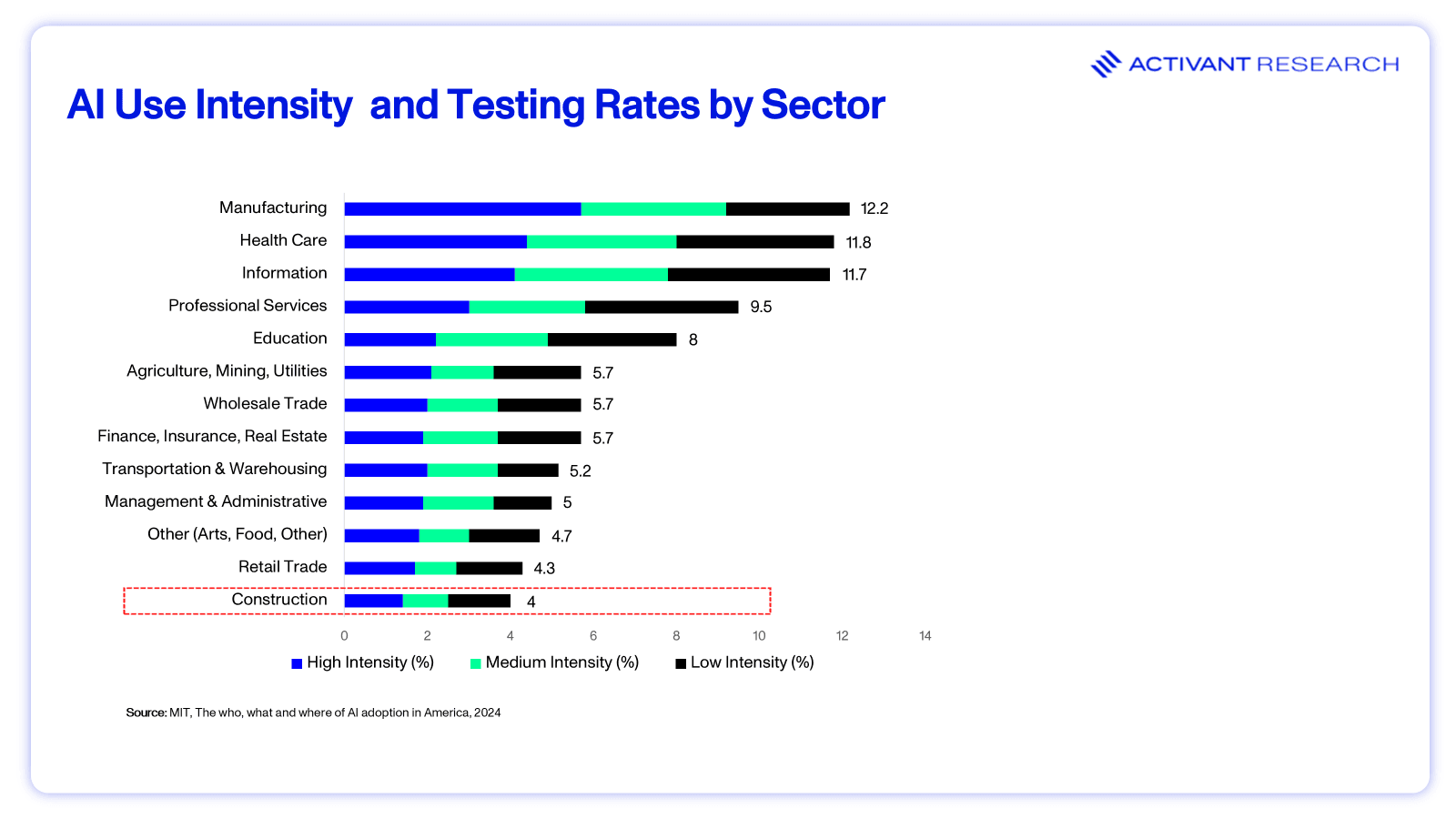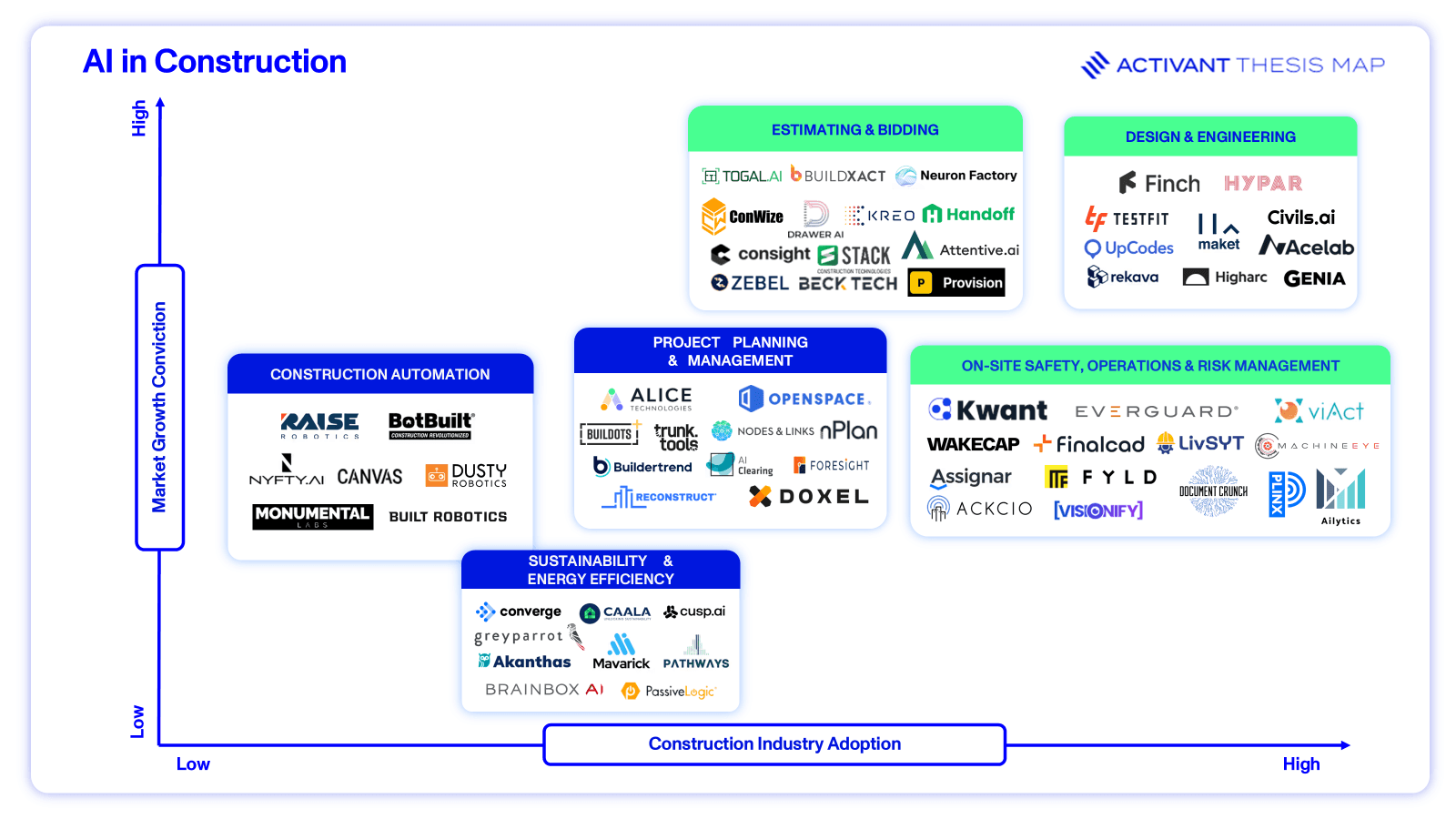Topic
AI
Published
November 2025
Reading time
14 minutes
The Blueprint for a Smarter Future
AI's Role in Construction
The Blueprint for a Smarter Future
Download ArticleResearch

Artificial intelligence won’t build your house tomorrow, but it may already be designing it, estimating the budget and optimizing your jobsite. Long perceived as a digital laggard, the construction industry is slowly shifting gears. Traditionally reactive and slow to adopt new technologies, the industry is now increasingly exploring AI not just as a tool, but as a transformative collaborator.
AI has the potential to fundamentally shift how the sector operates but the path remains long, fragmented, and full of resistance. In RICS’s AI in Construction 2025 survey, ~45% of respondents said their organisations don’t use AI, 34% are only in early pilots, and fewer than 12% regularly use it in a specific process.1 Still, the tide is turning: the report found that AI has emerged as the leading construction technology for increased investment, with 56% of respondents planning to allocate more funds to it than the previous year.2
The construction industry is cautiously optimistic about AI. While there appears to be excitement around productivity and safety gains, adoption is slowed by legacy systems, fragmented workflows, and a lack of AI literacy among field teams. Construction’s slow digitization leaves data unstructured, keeping processes manual and AI underutilized. This creates a classic paradox: AI depends on digitization to work, yet digitization often stalls without clear AI-driven value. Risk aversion deepens the gap as contractors are hesitant to adopt AI tools that aren’t nearly flawless, especially when errors could lead to catastrophic outcomes like structural failures.
As part of our ongoing research within the construction space, we’ve mapped out where AI is taking hold and where gaps persist. Construction Technology (ConTech) startups, in particular, offer an easier and simpler route for construction players to begin implementing AI solutions. While adoption is far from uniform, we're starting to see meaningful traction in specific functions where efficiency gains are undeniable.
Laying The Groundwork: From CAD to Cognitive Agents
AI-powered systems for construction have been evolving over the last two decades. The roots trace back to the 1960s, when Computer-Aided Design (CAD) first made it possible to digitally draft and optimize construction plans. In the following decades, Computer-Aided Manufacturing (CAM) and Computer Numerical Control (CNC) machines began streamlining the production of building components.
By the early 2000s, machine learning emerged as a new frontier. Initially, AI's role was largely confined to predictive analytics, primarily applied to asset maintenance and project scheduling. Construction firms began leveraging machine learning models to forecast equipment failures, identify cost overruns, and optimize workforce deployment. These early use cases were often siloed, but they laid the groundwork for a broader shift in mindset across the industry.
A turning point came in the 2010s, as Building Information Modeling (BIM) became more data-rich and accessible computing power unlocked new AI capabilities. While BIM isn’t an AI technology, it provided the structured data needed to fuel machine learning models. Robotic automation then began appearing on construction sites: Built Robotics introduced autonomous excavation and Fastbrick Robotics developed systems for robotic bricklaying, proof that AI could now physically shape the built environment.
In the late 2010s and early 2020s, the rise of computer vision and wearable tech enabled proactive safety measures. Construction companies could now use AI to predict and prevent hazards in real time, marking a shift from reactive to predictive safety cultures and helping firms mitigate one of the most persistent risks in construction.
The timeline below highlights the various technological changes that we believe have helped pave the way for the introduction of AI within construction.
Research

Today, AI supports every phase of construction, from generative design that optimizes cost and efficiency, to bidding platforms that streamline procurement, and digital twins that simulate projects before breaking ground. Even 3D printing is evolving with AI-guided modular and nuclear components. Experts see the greatest impact in pre-construction, where design, estimating, and bidding can be largely automated.
Despite this progress, widespread adoption remains uneven. Many firms still struggle with outdated systems, fragmented data environments, and a workforce in need of digital upskilling. The opportunities are vast, but the ability to fully implement AI solutions is out of reach for many small and mid-sized players in the construction space.
Current State of Play
Experts describe construction as a “slow-moving business," where technology trends can take 15 to 20 years to take hold. Despite its potential, AI adoption in construction remains limited. A 2025 MIT Sloan study revealed that 65% of construction leaders reported their companies are not yet using AI or predictive analytics for planning or execution.3
The chart below highlights construction’s slow AI adoption, showing how it lags well behind sectors like manufacturing, information, and healthcare. With one of the lowest shares of high-intensity AI use, the industry’s gap highlights both the urgency and the opportunity to accelerate adoption.
Research

This paints a picture of an industry that is eager to embrace the potential of AI but is still grappling with significant challenges. The rise of ConTech startups is helping accelerate experimentation and progress, but integration into legacy systems remains complex. In our recent report, Breaking Ground, we mapped the ConTech space and identified a growing wave of players with an AI-focused approach.4 We believe that these startups are likely to become the catalysts for meaningful AI implementation within the industry.
The Architecture of Change: Construction’s AI Shift
The construction industry is only just beginning to embrace AI in meaningful ways, but the foundation is being laid for far broader and deeper integration. Change is happening gradually—often in isolated pilot programs or within forward-thinking firms—but as technologies mature, costs decrease, and the pressure to innovate grows, we expect adoption to accelerate. AI enables predictive planning, real-time site monitoring, and automation of repetitive tasks. These capabilities can help reduce delays, improve resource allocation, and enhance safety, potentially boosting construction productivity by up to 20%.5
We see four major shifts shaping construction’s AI transformation:
1. From Tools to Teammates
AI is shifting from a background utility into an active participant in construction workflows. What used to involve a lengthy chain of communication and multiple tools can now be managed by a single AI agent, reducing both time and error. These agents are increasingly capable of handling complex sequences of tasks. Communication between clients, contractors, and suppliers is speeding up, with some adopters reporting efficiency gains of as much as 50%.6
2. Reshaping Roles, Not Replacing Jobs
While AI could automate up to 49% of construction tasks, this doesn’t necessarily translate to job losses.7 Instead, it’s likely to automate what many consider the "second job" of project managers and superintendents: scheduling, reporting, compliance, and other repetitive administrative functions.
By offloading routine work, AI allows construction professionals to focus on high-value responsibilities like decision-making, risk mitigation, and stakeholder coordination. Job descriptions will evolve to reflect the orchestration of both human teams and AI agents.
3. Consolidating Digital Chaos
The modern construction tech stack is notoriously fragmented. Teams often use one platform for scheduling, another for design, and still others for compliance and safety tracking. Autodesk found that 51% of construction teams are manually transferring data between apps that don’t integrate.8 This fragmentation introduces inefficiencies and silos but AI has the potential to unify these scattered systems. A well-designed AI assistant could eliminate the need to juggle multiple platforms, creating streamlined, outcome-focused workflows that reduce confusion and error.
4. The New Contract: Trust and Transparency
As AI adoption on construction sites grows, so do questions about data ownership and transparency. To earn the trust of users and stakeholders, the industry must implement systems akin to "data passports". These permissions-based frameworks define who can access, use, and audit the data captured from drones, sensors, BIM models, and wearables.
AI in construction remains nascent, but its influence is now visible across nearly every part of the value chain. While adoption is far from uniform, we're starting to see meaningful traction in specific functions where efficiency gains are undeniable.
Mapping The Frontlines of AI Disruption in Construction
AI is rapidly being woven into the core of how work gets done within construction. We see six areas where disruption is underway across the value chain, led most strongly by Estimating & Bidding, Design & Engineering and On-site Safety, Operations & Risk Management.
Research

Design and Engineering: AI is reshaping building design by improving accuracy, optimizing layouts, and ensuring compliance from the start. Zaha Hadid Architects report that AI tools have doubled or tripled productivity in early-stage design.9 Generative tools allow architects to test thousands of options based on cost, sustainability, and codes, while AI-enhanced BIM simulates conditions, detects clashes, and automates routine tasks.
- TestFit enables developers, architects, and contractors to instantly generate optimized site plans, considering zoning, cost, and yield constraints.
- Finch, a "generative copilot" for architects, uses AI graph technology, and advanced algorithms to create floor plans, massing layouts, and performance feedback.
- Civils.ai provides an AI-powered, no-code platform that transforms the way civil engineers and construction professionals interact with project documentation.
Engineering design today is manual, repetitive and prone to error. Yet engineers already have access to plenty of piecemeal solutions. The current workflow requires a structural, not incremental, change, and only an AI-powered, all-in-one platform can deliver the ultimate efficiency engineers need. Construction carries high liability and demands exceptional accuracy. While AI is powerful, it isn’t perfect, which is why Genia’s philosophy is to augment structural engineers, not replace them. We empower them by automating manual, repetitive tasks like calculations and drafting, freeing them to explore more design solutions and focus on critical decisions.”

Zhihao Zhao Co-Founder & CEO, Genia
Estimating and Bidding: Construction estimations and bidding (“takeoff”) have traditionally been manual and time-consuming. After architects and developers create a design, general contractors prepare bids from blueprints and then repeat the process with subcontractors. AI-powered software now automates material estimation with greater precision, speeding up workflows by up to five times.10
- Togal AI automates construction plan takeoffs, completing up to 80% of the process in seconds, rather than hours.
- Zebel transforms manual, spreadsheet-heavy estimating into fast, data-driven workflows, delivering accurate cost estimates and market benchmarks in minutes.
- Drawer AI uses generative tools to automate electrical takeoffs from blueprints, cutting estimator time by up to 70% while improving accuracy.
On-Site Safety, Operations & Risk Management: AI is improving construction safety by identifying hazards, enforcing protocols, and reducing accidents in real time. According to Autodesk and Deloitte, enhanced data utilization has already boosted on-site safety conditions for 24% of businesses.11 Tools like computer vision check PPE and unsafe behaviors, drones track progress against BIM models, and AI surveillance provides 24/7 site monitoring.
- Kwant AI uses smart wearables, real-time location tracking, and predictive analytics to create a digital twin of the construction workforce. This improves site safety, productivity, and compliance.
- Document Crunch is an AI-powered risk-management platform for the construction industry that helps general and specialty contractors, insurers, and sureties rapidly review contracts, specifications, and other project documents to uncover hidden risks.
- Everguard.ai uses AI and sensors to detect risks like missing PPE, falls, or dangerous zones, alerting teams before accidents happen.
Most construction disputes don’t come from major failures, they come from small oversights buried in complex documents. By putting trusted expertise directly in the hands of every team member, AI helps us surface those risks earlier, protect relationships, and deliver projects the way they were meant to be delivered: with confidence.”

Josh Levy CEO and co-founder, Document Crunch
We are generally less interested in AI tools within project planning and management, sustainability and energy efficiency and construction automation, but there are still players within these segments that are worth noting.
Project Planning and Management: AI is improving construction planning by enabling smarter scheduling, predictive analytics, and proactive risk management. A 2024 study published in the Journal of Construction Engineering and Management found that the use of AI in construction planning can reduce project delays by up to 30% and decrease rework by as much as 50%.12 By factoring in weather, supply chains, and labor data, it helps prevent delays and budget overruns. Even basic AI-enhanced management tools can be game-changing, especially for small and mid-sized contractors.
- Doxel AI uses computer vision and BIM integration to provide fully automated, real-time construction progress tracking. This enables teams to deliver projects up to 11% ahead of schedule and reduces billing friction by as much as 21%.
- nPlan leverages a repository of over 750,000 historical project schedules to predict construction timelines and risks.
Sustainability and Energy Efficiency: AI is helping the construction industry reduce its environmental impact by optimizing materials, energy systems, and carbon assessments. This technology's speed and efficiency make difficult tasks, such as connecting renewable energy sources to the electric grid, much more manageable. This is a crucial development, as according to a 2024 UN report, the global building and construction sector is responsible for 34% of global carbon emissions.13
Building materials contribute nearly 11% of real estate sector emissions, pushing the construction industry to adopt more sustainable methods.14 This shift is driving demand for environmental disclosures like Environmental Product Declarations (EPDs) and the summaries of a Life Cycle Analysis (LCA), which includes a verified assessment of a building material’s environmental impact.
- Pathways, a New York-based platform, automates the creation of real-time LCAs and EPDs for building material manufacturers.
Construction Automation: AI-driven automation is redefining how buildings are physically constructed, with machines increasingly taking on repetitive or hazardous tasks. These technologies cut labor costs and timelines, and unlock new levels of consistency and design complexity that are difficult to achieve with traditional methods.
- Built Robotics enables autonomous excavation, grading, and trenching, reducing labor bottlenecks while increasing speed and precision.
- Nyfty.ai acts as a digital assistant for construction teams, using AI-powered SMS, QR codes, and smart access to automate daily field processes.
Overcoming The Barriers to AI Adoption
Despite the benefits, several obstacles continue to impede widespread AI adoption in construction. The industry’s inherent resistance to change remains one of the main barriers. Construction has traditionally been slow to adopt new technologies, often due to concerns about cost, complexity, and potential disruption to established workflows. Many construction firms, particularly smaller ones, may lack the resources or expertise to implement AI effectively.
The workforce itself presents another challenge. Roughly one-third of construction firms cite lack of training and technical integration as major adoption hurdles.15 The industry must address this digital skills gap by providing comprehensive training that encourages collaboration with AI tools rather than fear of replacement. Workforce heterogeneity adds another layer of complexity, with highly technical professionals working alongside field crews, making intuitive, user-friendly interfaces essential for adoption across the job site.
The cost of implementing AI solutions is another obstacle, particularly for small and medium-sized construction firms. AI systems require substantial upfront investment in software, hardware, and training. The combination of high implementation costs and complex ROI justification processes, particularly due to the need to "sell software twice" (to both contractors and project owners), complicates adoption. Given that construction is typically a low-margin business with an average profit margin of 6%, players are hesitant to fund experimentation, preferring proven technologies over untested innovations.16
Infrastructure limitations compound these challenges. Construction sites, especially in remote locations, may lack the necessary connectivity and hardware to support AI solutions effectively. Reliable internet access, robust data management systems, and sufficient computing power are required to make the most of AI tools and construction companies will need to invest in upgrading their infrastructure to fully leverage them. This also impacts vendors, as inconsistent IT hardware setups across project teams pose significant deployment hurdles.
To overcome these challenges, a phased approach to AI integration offers a practical way forward. Rather than attempting full-scale implementation, firms can begin with smaller, more manageable AI projects targeting specific pain points, such as improving safety monitoring or automating routine tasks. This approach allows for a gradual learning curve and helps build internal expertise and confidence in AI technologies.
Collaborating with ConTech partners experienced in AI can further accelerate adoption, providing access to shared resources and training.
In construction, every project is essentially a prototype — no two are the same, even if you're building the same retail store, it's on a different piece of land, using different suppliers of materials, etc. That makes it incredibly difficult to capture the kind of structured, repeatable data that traditional machine learning models depend on. Overcoming this barrier requires thinking about AI more broadly - not just as data-driven prediction, but as a suite of tools that can augment human expertise, automate decisions, and adapt to the unique, dynamic nature of each build.”

Laura Paciano SVP of Growth at TestFit
Reprogramming Construction
Contractors face a pivotal moment: the opportunity to leapfrog outdated digital tools through AI, while contending with the industry’s deep-rooted traditions that make modernization a major challenge.
AI adoption in construction is still in its infancy, with many firms navigating legacy systems, fragmented tools, and cultural resistance. We’re seeing fragmented early-stage implementation where AI is the hammer, and everything's the nail. There are also many point solutions addressing isolated issues such as codes, compliance, permitting and take-off; and industry leaders are beginning to invest in AI not as a trend, but as a practical solution to long-standing challenges in efficiency, safety, and sustainability.
The transformation may not be uniform or rapid, but the direction is clear. AI is set to redefine how buildings are designed, planned, and built. We believe that the firms that choose to experiment, invest, and integrate AI technologies today will not only gain operational advantages, but also position themselves as leaders in the next phase of construction.
Endnotes
[1] RICS, RICS artificial intelligence in construction report, 2025
[2] Ibid.
[3] Slate, Is Construction Ready for AI? Industry Survey Report, 2025
[4] Activant Research, Breaking Ground, 2025
[5] Construction Today, The Rise of Artificial Intelligence in Construction, 2024
[6] NEDES, Role of AI In The Construction Industry, 2025
[7] Fortune Business Insights, AI in construction market, 2025
[8] Digital Builder, Construction Software Integrations: Putting an End to Manual Workflows, 2025
[9] The Times, Zaha Hadid Architects builds “winner proposals” with AI, 2025
[10] NEDES, Role of AI In The Construction Industry, 2025
[11] Fortune Business Insights, AI in construction market, 2025
[12] Construction Management Association of America, The Need For AI in Construction, 2024
[13] UN environment programme, Global Status Report for Buildings and Construction, 2025
[14] TFN, This AI climatetech founded by Harvard classmates raises $2.5M to achieve green construction,2024
[15] Bluebeam, Building the Future: Bluebeam AEC Technology Outlook, 2025
[16] Autodesk, Average Profit Margin For The Construction Industry, 2025
The information contained herein is provided for informational purposes only and should not be construed as investment advice. The opinions, views, forecasts, performance, estimates, etc. expressed herein are subject to change without notice. Certain statements contained herein reflect the subjective views and opinions of Activant. Past performance is not indicative of future results. No representation is made that any investment will or is likely to achieve its objectives. All investments involve risk and may result in loss. This newsletter does not constitute an offer to sell or a solicitation of an offer to buy any security. Activant does not provide tax or legal advice and you are encouraged to seek the advice of a tax or legal professional regarding your individual circumstances.
This content may not under any circumstances be relied upon when making a decision to invest in any fund or investment, including those managed by Activant. Certain information contained in here has been obtained from third-party sources, including from portfolio companies of funds managed by Activant. While taken from sources believed to be reliable, Activant has not independently verified such information and makes no representations about the current or enduring accuracy of the information or its appropriateness for a given situation.
Activant does not solicit or make its services available to the public. The content provided herein may include information regarding past and/or present portfolio companies or investments managed by Activant, its affiliates and/or personnel. References to specific companies are for illustrative purposes only and do not necessarily reflect Activant investments. It should not be assumed that investments made in the future will have similar characteristics. Please see “full list of investments” at https://activantcapital.com/companies/ for a full list of investments. Any portfolio companies discussed herein should not be assumed to have been profitable. Certain information herein constitutes “forward-looking statements.” All forward-looking statements represent only the intent and belief of Activant as of the date such statements were made. None of Activant or any of its affiliates (i) assumes any responsibility for the accuracy and completeness of any forward-looking statements or (ii) undertakes any obligation to disseminate any updates or revisions to any forward-looking statement contained herein to reflect any change in their expectation with regard thereto or any change in events, conditions or circumstances on which any such statement is based. Due to various risks and uncertainties, actual events or results may differ materially from those reflected or contemplated in such forward-looking statements.

